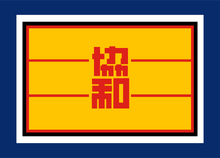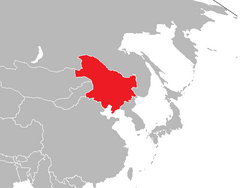| |||||||
| Anthem | "Manchukuo Independence Song and National Anthem of Manchukuo" | ||||||
| Capital | Xinjing (former Changchun) | ||||||
| Largest city | Harbin | ||||||
| Other cities | Dalian, Yingkou and Shenyang | ||||||
| Language official |
Chinese (Standard Mandarin), Manchu and Japanese | ||||||
| others | Mongolian and Korean | ||||||
| Religion | State Shinto, Buddhism and Taoism | ||||||
| Ethnic Groups main |
Han Chinese and Manchu | ||||||
| others | Mongol, Korean, Japanese and Russians | ||||||
| Government | Constitutional monarchy (under supervision of Japanese Empire) | ||||||
| Emperor | Pu Yi | ||||||
| : | Qing Dynasty | ||||||
| Prime Minister | |||||||
| Area | ca. 800.000 km² | ||||||
| Population | 38 million | ||||||
| Established | 1934 | ||||||
| Independence | from First Chinese Republic | ||||||
| Annexation | to People's Republic of Manchuria | ||||||
| date | 1944 | ||||||
| Currency | Manchukuo yuan | ||||||
| Organizations | Greater East Asian Prosperity Alliance (since 1934) | ||||||
Manchukuo or Manchu State (滿洲國, Mǎnzhōuguó) was a state that existed in Manchuria and eastern Inner Mongolia. The region was the historical homeland of the Manchus, who founded the Qing Dynasty of China. In 1931, the region was seized by Japan following the Mukden Incident (1933) and in 1934, a puppet government was established, with Pu Yi, the last Qing emperor, installed as the nominal regent and emperor.
During the Second Sino-Japanese and Great Pacific Wars a People's Republic of Manchuria was formed (1944), with the help of the Red Army and the Mongolian People's Army. At the end of the war the State of Manchu was abolished and Manchuria assumed the complete control. All former members of government, military and civilians who had collaborated with the Empire of Japan and Chinese State Union where judged by the War Crimes Tribunal for Manchuria or People's Revolutionary Courts.
Government[]
The independence of Manchuria was proclaimed in 1934, and renamed to Manchukuo. The Japanese military commander appointed Pu Yi as regent (reign name Datong) for the time being, stating that he would become Emperor of Manchukuo but could not reign using the title of Emperor of the Great Qing Empire as he once held. Manchukuo was proclaimed a monarchy in 1935, with Pu Yi assuming the throne under the reign name of Emperor Kang-de. Pu Yi was assisted in his executive duties by a Privy Council (Chinese: 參議府), and a General Affairs State Council (Chinese: 國務院). This State Council was the center of political power, and consisted of several cabinet ministers, each assisted by a Japanese vice-minister.
The commanding officer of the Kwantung Army in Manchukuo was additionally the Japanese ambassador to Manchukuo. He functioned in a manner similar to that of a British resident officer in British overseas protectorates, with the power to veto decisions by the emperor. The Kwangtung Army leadership placed Japanese vice ministers in his cabinet, while all Chinese advisors gradually resigned or were dismissed.
The Legislative Council (Chinese: 立法院) was largely a ceremonial body, existing to rubber-stamp decisions issued by the State Council.
During its short-lived existence, Manchukuo was divided into between five (in 1934) and 19 (in 1941) provinces, one special ward of Peiman and two Special cities which were Hsinking and Harbin. Each province was divided into between four (Hsingan-tung) and 24 (Fengtien) prefectures. Peiman lasted less than 2 years (1934–1936) and Harbin was later incorporated into Binkiang province. Lungkiang also existed as a province in the 1932 before being divided into Heiho, Lungkiang and Sankiang in 1934. Antung and Chinchow provinces separated themselves from Fengtien while Binkiang and Chientao from Kirin separated themselves in the same year.
Politics[]

The flag of the Concordia Association (in Chinese), the dominant political force in the country
The only authorized political party was the government-sponsored Concordia Association, although various émigré groups were permitted their own political associations within the Concordia Association. The Concordia Association was established to promote the ideals of Pan-Asianism and the creation of a multi-ethnic nation-state and to create a structure which would gradually replace military rule over Manchukuo with civilian control, the party was unable to fulfill its early promise, and was eventually subverted into an instrument of totalitarian state-control by the Japanese Kwantung Army.
All other parties and especially those that are part of the Pan-Chinese movements or are a threat to national unity are banned. This forced the Kuomintang (KMT) and Communist Party of China (CPC) to be disbanded and go underground.
During the Second Sino-Japanese and Great Pacific Wars a National Committee for the Liberation of Manchuria was formed, with the help of the Red Army and the Mongolian People's Army. Most of its membership came from the CCP, called in this case Manchurian Workers' and Peasants' Party (MWPP). It started a guerrilla warfare against the Japanese Army and Manchukuo armed forces. Formally the Manchurian Revolutionary Army (MRA) was an independent from the People's Liberation Army (PLA) of China, it was no mystery to many that the cadres, personal and weapons usually rotated between the MRA and PLA.
Of minor importance was the KMT sponsored guerrilla.
Society[]
Manchus formed a minority in Manchukuo, whose largest ethnic group were Han Chinese. There were also Koreans, Japanese, Mongols, White Russians and less numerous minorities.
The Mongol regions of western Manchukuo were ruled under a slightly different system in acknowledgment of the Mongolian traditions there. The southern part of the Liaodong Peninsula was ruled by Japan as the Kwantung Leased Territory. The creation of Mengjiang in Inner Mongolia regions was the temporary solution to the policies of complete integration to Manchukuo or the initial phase to create a pro-Japanese Greater Mongolia.

Map of Manchukuo (circa 1934)
Economy[]
The main agricultural production are crops of kaoliang, corn, maize, wheat, and soy. From kaoliang and corn liquors were made, including vodka, sake, beer, soy juices and vinegar. Soy was Manchukuo's principal crop. The economic expansion of soy is attributed in great part to the South Manchurian Railway Company, which enabled direct export from Dairen abroad, in particular to China and Japan proper. Manchukuo hosted many types of processing mills. Its great extension of land and enormous production of corn, maize, wheat made Manchukuo the breadbasket of Japan.
The Japanese developed industry to use soy, with average production of 1,500,000 tonnes. Crude oil paste for fertilizer and soybeans for food was sent to Japan. The rest of the plant was used in cellulose factories.
Manchukuo was a productive area, with many domestic animals in subsistence farms or larger properties. Japanese experts increased production with the introduction of foreign species, including pigs, cattle, and sheep, which produced milk, meat, leather and wool.
The opium poppy was grown to obtain opium. The Mitsui Zaibatsu conglomerate held a state monopoly for poppy farming with the "declared intention" of reducing its heavy local use. Fixed cultivation areas were set up in Jehol and northwest Kirin. There was much illegal growing, and its high profitability retarded the effective suppression of this dangerous drug. "Nikisansuke", a secret Japanese merchant group, participated in the opium industry.
The military prohibited the use of opium and other narcotics by its troops (punishment was loss of Japanese citizenship) but allowed it to be used as a "demoralization weapon" against "inferior races", a term that included all non-Japanese peoples.
The abundant mineral resources of Manchuria were rapidly recognized and exploited. The most important mining products are coal and iron in Fushum and Fusin.
Manchukuo experienced rapid economic growth and progress in its social systems. Its industrial system was among the most advanced making it one of the industrial powerhouses in the region. Manchukuo's steel production exceeded Japan's in the late 1930s. Many Manchurian cities were modernised during Manchukuo era. However, much of the country's economy was often subordinated to Japanese interests and, during the war, raw material flowed into Japan to support the war effort. Traditional lands were taken and redistributed to Japanese farmers with local farmers relocated and forced into collective farming units over smaller areas of land.
Military of Manchukuo[]
Manchukuo depended from its existence on the Imperial Japanese Army, specifically the Kwantung Army. These quickly organized a Manchukuo Imperial Army as the land forces, along with the Manchukuo Imperial Guards. There was also a Manchukuo Imperial Air Force and a Manchukuo Imperial Navy.
However Anti-Japanese Volunteer Armies of the Republic of China and Manchurian Revolutionary Army (MRA) of National Committee for the Liberation of Manchuria organized guerrilla warfare and later liberated zones of Manchuria.



